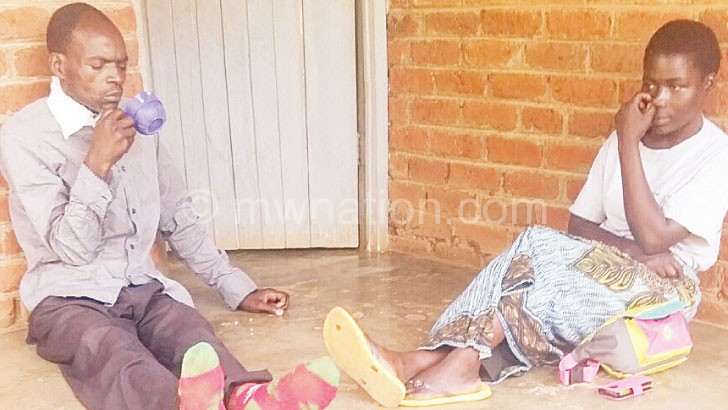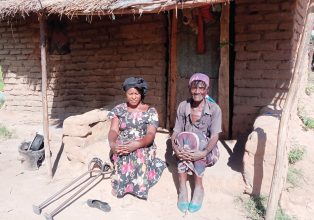Likwenu Dam spurs typhoid outbreak
The prevailing typhoid outbreak in Zomba mirrors costly aftermaths of neglecting water, sanitation and hygiene. ALBERT SHARRA writes.
Around 10am, we venture into Malosa, Zomba’s food basket. The streets are busy, with the locals selling maize, rice, cassava, vegetables and other crops.

However, the buzzing business activity silently eclipses a health scare that is running deep in the community as the eastern suburb of the colonial capital is making headlines more for a typhoid outbreak than the fresh produce the countryside is well known for.
At Likwenu Primary School, it was clear the disease is haunting the rural population.
When we arrived at the isolated school at the bottom of Malosa Hills, Benson Kamando, a teacher at the school, had been bed-ridden for three weeks. He shivered with fever, appeared pale and frail. He struggled to gulp down a cupful of porridge. The man was visibly in pain and could not walk.
There was no improvement almost 21 days since he went to Cobbe Barracks Clinic where he tested malaria negative. Together with head teacher Anthony Mandawala, we drove the patient to St Luke’s Anglican Hospital where he was later admitted having been diagnosed with typhoid.
As he groaned with pain, the head teacher told us: “He is not the first patient. We have five more, including my daughter and wife. We are living in fear.”
The panic is spreading deep in the pastoral community and everyone is at risk of the outbreak which forced St Luke’s College of Nursing and Malosa Secondary School to close two weeks early.
So far, the patients include 200 learners at the secondary school and 100 at the nursing college.
The population hit is higher as it sprawls beyond the bounds of the clustered learning institutions.
Zomba district health office, which ruled out death so far, could not come clear when asked about the gravity of the outbreak.
However, the major tragedy is that authorities do not seem to agree on how to stop the outbreak from the source.
In the area, the disease, which is associated with poor hygiene, is spreading with every water drop.
On the ground, frail patients bask in the sun, getting weaker and weaker as they are hastily put on Artemether-Lumefantrine (LA) and other malaria dosages.
At St Luke’s Hospitals, the patients join the queue one-by-one—with both children and adults getting a late awakening that they are actually suffering from typhoid.
According to St Luke’s College principal Maxwell Pindani, they first noticed the outbreak in the final week of June, almost two weeks before it was declared a public health crisis by the Ministry of Health on July 13.
A month after they traced the outbreak to Likwenu, the area is not free from typhoid as authorities are dillydallying on calls to cordon off a dam they have since identified as the source of the outbreak.
Source of the outbreak
Zomba District Health Officer (DHO) Gift Kawalazira and Southern Region Water Board (SRWB) spokesperson McDonald Phiri point to Likwenu Dam as the source of the public health crisis.
In their minds, Anglican missionaries envisaged the dam providing safe water for the worst hit institutions—the hospital, college, Malosa Secondary School and Likwenu Primary School and the surrou-nding commu-nities.
Howe-ver, a recent inquiry into the outbreak shows the intake of the locality’s cherished tap water is infested with bacteria called salmonella typhi which causes the disease.
Despite the shocking findings, the community members are still drinking the unsafe water as the government agencies have not acted on recommendations to “temporarily close down the dam” to pave way for water treatment.
Kawalazira says: “The dam is heavily infested withbacteria, but we do not have requisite expertise in water mana-gement. SRWB is handling the matter.”
The SRWB publicist indicates that the water suppliers resolved to send quality certifiers to audit the state of the dam and selected taps to ascertain the type and quantity of chemi-cals required for treating the unsafe water.
“After these activities, the board will advise the owners of the water supply system on what needs to be done to
make that water safe
for human consumption,” Phiri said.
The outbreak continues
Though the public servants say they are winning the battle to make Zomba typhoid-free, the outbreak is not relenting and fears are gaining sway that it may spread to other areas.
In the surrounding villages, almost six out of 10 families confirm being haunted by the disease that most health workers mistake for malaria.
The tricky thing is that signs and symptoms—high body temperature, headache, weakness, abdominal pains and constipation-resembles those associated with malaria, Ministry of Health principal secretary Macphail Magwira confirmed.
The majority of them are stuck on the sickbed for over two weeks after taking pointless malaria tests and drugs.
Here, only as few as one in five patients claim to have been successfully treated from typhoid.
“We pay bicycle taxi operators K500 to rush us to the health centre where we pay for treatment, including the futile malaria tests. Where do we get the money?” asks survivor Emily Sekeni.
Equally hit are businesspersons, especially vendors of fresh vegetables, fruits, chips and fritters.
Ackim Selemani, who sells chips at Malosa, laments “a drastic drop in business” as he keeps receiving fewer customers since the outbreak began.
Most of his customers include unsuspecting travelers and visitors, increasing the likelihood of the migrants spreading the disease to the rest of the district and the country.
Pindani says the college will not reopen until a month elapses, for it takes 30 days for signs and symptoms to become discernible.
Kawalazira spoke of a falling trend as health centres that used to see almost 200 patients a week at the beginning of the outbreak now treat no more than 35.
However, the trends of the outbreak confirm the needs for greater awareness and investment to highlight the importance of safe water, sanitation and hygiene when it comes to public health.
From the neglected dam, it is clear relevant decision-makers need to speed up life-saving efforts to overcome the outbreak. n
TYPHOID FEVER FAST FACTS
- Germs transmitted through ingesting food or drinks contaminated by faeces or urine of infected people.
- Symptoms and signs appear one to three weeks later.
- They include high fever, malaise, headache, constipation or diarrhoea, rose-coloured spots on the chest and enlarged spleen and liver.
- It can be treated with antibiotics.
- Insist on safe water, sanitation and hygeine
- Avoid open defecation—Who




